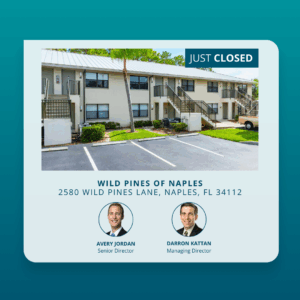Multifamily development is surging across Florida with many developers racing to satisfy pent-up demand. Approximately 25,000 units are recently built or under construction, with another 13,000 units planned in the South Florida metro area of Palm Beach, Broward and Miami-Dade counties. There’s an additional 25,000 units planned or under construction in Orlando, Tampa and Jacksonville combined.
There are nearly 2.4 million renters living within 1.3 million apartment homes in the state of Florida. These renters make an economic contribution of $44.8 billion per year while supporting over 270,000 jobs, according to data compiled by the National Multifamily Housing Council and the National Apartment Association.
Florida’s multifamily sector continues to experience consistently high occupancies, steady rent growth, a restrained development pipeline and a healthy debt market. The confluence of these factors has given apartment markets in the Sunshine State remarkably solid fundamentals. There is continued compression in cap rates for properties across virtually all markets in Florida as demand continues to outpace supply, and there is a lack of product for sale compared to the last two years. With limited supply available, core and value-add opportunities continue to be highly sought after by institutional buyers, large private groups and individual investors. The interest rate environment is still very attractive, which should continue through the first half of 2015.
According to the U.S. Census Bureau, the national homeownership rate peaked at 69.2 percent in 2004, fell to 64.8 percent by the first quarter of 2014, and is forecasted to drop to 55 percent over the next few years. Each 1 percent drop in the homeownership rate adds approximately 1 million renters to the market, and the state of Florida estimates that 1,000 people move to the state every day.
Another strong factor driving the hot multifamily sector is the Millennial generation, poised to become the largest U.S. demographic this year, surpassing baby boomers. Millennials are driving demand for higher-end housing closer to the urban core, fueling rental increases, which in turn is making homeownership more cost effective in many cases.
Within the multifamily market, asking rents across Florida are above pre-recession levels and show no signs of abatement. Additionally, occupancy throughout Florida remains above 95 percent and the condo market is strengthening with converters back in the market looking for multifamily product to reposition as for-sale, which will further constrain supply. This shortage is due partly to changing demographics, the fact that 60,000 rental units were converted to condominiums in the last cycle and that the recession halted development for a number of years. Value-add properties are also recording strong activity. Investors seeking stronger returns on investment properties are acquiring older vintage properties and adding value through interior and exterior upgrades.
Apartment prices as measured by the Moody’s/RCA CPPI were up 10 percent in the year after the first quarter of 2015 and are now 21 percent ahead of peak prices seen in 2007 prior to the global financial crisis. Investors hungry for yield still find the immediate returns from the apartment sector attractive, and this strong appetite is also fueling development activity as there is more appetite than availability of product.
Tampa Bay
Approximately 13 percent of the Tampa Bay area’s population live in apartments. There are more than 366,000 renters living in 204,000 apartment homes and they contribute $7.2 billion to the local economy per year while supporting over 74,000 jobs. An improving local economy in Tampa helped drive significant new apartment construction in 2014 and the metro recorded a 10-year high in terms of new demand in 2014.
There is significant infill apartment and condo development taking place in and around the downtown. St. Petersburg and downtown Tampa cores. While downtown areas can be challenging places to build apartments due to a constrained supply of land, the “live-work-play” lifestyle is appealing to Millennials and urban dwellers. The trend has motivated developers to get creative and find unique ways to build vertically with enhanced amenity packages in order to overcome land limitations, while also attracting renters seeking proximity to jobs, shopping, entertainment and transportation.
SkyHouse, an upscale multifamily project under construction in Tampa, is an excellent example. It rises 23 stories over the Channelside area with sweeping views of the waterfront Amalie Arena and downtown Tampa. Similar developments are planned in Tampa, including Related Group’s 340-unit, 21-story tower on Harbour Island; The Residences at the Riverwalk, a 380-unit, 36-store tower adjacent to the Straz Center on the Hillsborough River that will be complemented by a promenade of shops and restaurants; a mixed-use tower planned by Tampa Bay Lightning owner Jeff Vinik that could include 50 luxury residences with a concierge; and the Martin at Meridian, a 316-unit, 24-story tower also in the Channel District that may incorporate a grocery store. Similar projects in downtown St. Petersburg include Beacon 430, a mid-rise, 326-unit development on Third Avenue South; Modera Prime, a mid-rise, 309-apartment development on Third Avenue North; and 330 Third St. S., a 17-story, 348-unit development. Several condo projects are also planned, including the upscale 18-story Bliss project overlooking Beach Drive and The Salvador, a 13-story tower on 2nd Street South and Dali Boulevard.
Orlando
Apartment fundamentals in the Orlando metropolitan area are very strong. Approximately 15 percent of Orlando’s population, or 330,000 people, reside in nearly 165,000 apartment homes in the metropolitan area, and these rents make an economic contribution of $5.8 billion per year while supporting nearly 60,000 jobs. Healthy job creation, high occupancy rates and strong rent growth has been fueling great momentum for the Orlando apartment market. Nearly 6,000 new apartments planned for completion between 2015 and 2016 are resulting in roughly a 3 percent increase in total inventory. The potential economic impact of those new units is nearly $1.3 billion, with an estimated 11,800 jobs created, 2,048 of which are permanent.
The most active developers right now are Crescent Communities, which has two developments underway totaling $74.3 million and 529 units; Epoch Properties, with three communities totaling 706 units; LeCesse Development with two communities totaling $65 million and 476 units; and Integra Land with two new developments totaling $68 million and 547 units. The majority of the new development is taking place in North Seminole County; in the southwest Orlando near The Mall of Millennia, Sea World and the town of Celebration; and in south Orlando’s Lake Nona area. The Altman Cos. has established itself in the Dr. Phillips neighborhood with Altis at Sand Lake, a 315-unit Class A multifamily community. Several additional infill projects are cropping up in and around the downtown core catering to Millennials and urban dwellers.
Landlords benefiting from the steadily declining vacancy rate have seen increasing rents, resulting in forecasted rent growth of 6.0 percent by year-end 2015.
South Florida
With more than 1 million renters, or 18 percent of the Greater Miami area’s population, South Florida has re-emerged as both a lucrative investment market and an explosive development market. Solid rent growth of 7.5 percent is forecasted by year-end with new apartment, retail and mixed-use projects planned or under construction across the area. Many of these are clustered in the high-demand Brickell area of Miami. According to Cranespotters.com, there are 345 new condo towers in the pipeline, of which 95 are proposed, 117 are planned, 193 are in pre-sale, 106 are under construction and 27 are completed, including Brickell House in Miai, Adagio on the Bay in Fort Lauderdale, Beachwalk in Hallandale Beach and Apogee Beach in Hollywood.
The biggest development new in South Florida is the $2 billion Miami Worldcenter project, now slated for groundbreaking in the third quarter of 2015. The first phase of the 27-acre project will incorporate a 765,000-square-foot mall developed by Forbes Co. and Taubman and anchored by Bloomingdale’s and Macy’s, a 470-unit condominium developed by Daniel Kodsi, and a 429-unit apartment building to be built by Orlando-based ZOM.



